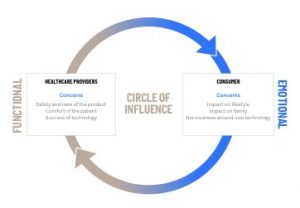 We’re all aware that technology is transforming every area of our lives, from our working environment, to planning our social lives, shopping for groceries, exercising, and even finding the loves of our lives. For almost any aspect of your daily life there’s some technology on offer designed to improve the experience.
We’re all aware that technology is transforming every area of our lives, from our working environment, to planning our social lives, shopping for groceries, exercising, and even finding the loves of our lives. For almost any aspect of your daily life there’s some technology on offer designed to improve the experience.
Consumers have adapted to this digitally enhanced routine with the greatest of ease. We’ve become as expectant of technological assistance, or enhancement, as if it’s a sort of birthright. So, why wouldn’t we expect to have our experience of healthcare improved by technology? The problem is, we do, but it’s not there yet…
1) You have more than one audience
The pharmaceutical sector is not unique in its need to address multiple audiences. Primarily the customers are:
(a) Consumers (patients)
(b) Healthcare Providers
 Both of these audiences will have different requirements of your brand, ranging from functional and results-driven reassurances (e.g. safety and risk) for Healthcare Providers, to the more emotive and real-life reassurances (e.g. impact on family) for Consumers. What’s important to note however is that, in most cases, one will inevitably influence the other as their relationships can often strengthen, and become more dependent upon each other for feedback when serious/long-term illness occurs.
Both of these audiences will have different requirements of your brand, ranging from functional and results-driven reassurances (e.g. safety and risk) for Healthcare Providers, to the more emotive and real-life reassurances (e.g. impact on family) for Consumers. What’s important to note however is that, in most cases, one will inevitably influence the other as their relationships can often strengthen, and become more dependent upon each other for feedback when serious/long-term illness occurs.
Because of this it’s imperative you consider the brand experiences for both audiences. By focusing on the individual expectations/needs of each, you’ll build stronger brand loyalty from both collectively. A quick and simple method to achieve this is to ensure you have dedicated areas on your website that talks directly to each audience. This enables them to access the information that is relevant for them, and provides reassurance that you’re focused on their individual needs.
2) Get out ahead of the conversation
 As of June 2017, 51% of the world’s population has access to the Internet. The Internet however is both a benefit and a bind for the pharmaceutical sector. Often, information found online about therapies and medicines etc. can be, at best, irrelevant to large numbers of consumers, or at worst, wholly inaccurate/misleading. It also means the majority of consumers are no longer limited to buying what’s available on the shelves in their local pharmacy. Nor are they limited to the amount of research they can do on products, or the feedback they can provide.
As of June 2017, 51% of the world’s population has access to the Internet. The Internet however is both a benefit and a bind for the pharmaceutical sector. Often, information found online about therapies and medicines etc. can be, at best, irrelevant to large numbers of consumers, or at worst, wholly inaccurate/misleading. It also means the majority of consumers are no longer limited to buying what’s available on the shelves in their local pharmacy. Nor are they limited to the amount of research they can do on products, or the feedback they can provide.
By taking the time to listen to consumers, understand their needs and connect with them through the technology they use (e.g.: SMS, Facetime or Skype), you can create greater long-term engagement and ensure the Internet is benefitting your brand, not binding it. Also, by actively managing the flow of information about your brand you can help provide the correct, most relevant information for consumers and, ultimately, take the lead on the conversation.
3) We’re not all digital natives
 Although we’re focusing on the rapid adoption of technology for the majority of consumers, we need to also be mindful that, for some consumers and healthcare providers, emerging technologies are not so easy to embrace. Certain audience groups, including many elderly consumers (who incidentally are often those who require more medical needs) can be understandably wary of technology. That’s not to mean they can’t use it, they just perhaps need a bit more support in doing so.
Although we’re focusing on the rapid adoption of technology for the majority of consumers, we need to also be mindful that, for some consumers and healthcare providers, emerging technologies are not so easy to embrace. Certain audience groups, including many elderly consumers (who incidentally are often those who require more medical needs) can be understandably wary of technology. That’s not to mean they can’t use it, they just perhaps need a bit more support in doing so.
If a brand is introducing technology to be used by non-digital savvy audiences, it’s their responsibility to design it to be accessible to all. Ensuring the brand design, UX and related comms are as approachable as possible will reassure consumers that you’re there to support them, not exclude them by introducing technology.
4) Put the consumer at the heart of your brand strategy
 When you consider the world’s leading brands, one of the key commonalities between them is that they all know their customers, inside out. They invest heavily in obtaining extraordinary insight into their target markets. With this insight, they create robust brand strategies that directly communicate with their core audiences in relevant and engaging ways. What’s remarkable is that the greater the level of engagement a consumer feels with a brand, the more likely they are to willingly provide more information and insight back to the brand.
When you consider the world’s leading brands, one of the key commonalities between them is that they all know their customers, inside out. They invest heavily in obtaining extraordinary insight into their target markets. With this insight, they create robust brand strategies that directly communicate with their core audiences in relevant and engaging ways. What’s remarkable is that the greater the level of engagement a consumer feels with a brand, the more likely they are to willingly provide more information and insight back to the brand.
For those of us who don’t have the budgets, or the reach of the likes of Apple and Coca-Cola, you can still manage this by simply putting the consumer at the heart of everything you do. What we mean by that is to consider the consumer wants and needs; how they might receive something, not only at launch but right from the product development stage. From name and brand identities, through to press releases and how to navigate your website – everything should be designed with the consumer in mind.
Something that resonates deeply with the branding challenges businesses face is a great quote from Maya Angelou – People don’t remember what you say or do, they remember how you make them feel.
Article by Nalla’s CEO, Vicki Young
About Vicki:
 Vicki graduated from Kingston University with a first-class degree in Graphic Design and earned two D&AD yellow pencils. Her career began working and collaborating with retail brand New Look, The London Mayor, Vodafone and The Royal Opera House.
Vicki graduated from Kingston University with a first-class degree in Graphic Design and earned two D&AD yellow pencils. Her career began working and collaborating with retail brand New Look, The London Mayor, Vodafone and The Royal Opera House.
In 2010 Vicki started her own branding agency Nalla, an agency that ensures the digital revolution isn’t ignored when creating a brand and uses technology as a tool within brand design.
As the sole founder and creative director of Nalla she has helped clients across a variety of sectors to build brands that are digitally robust and globally flexible ensuring Nalla has ambitious clients across the globe.
Recent clients include the award-winning rebrands of IMUK, .tickets, Informa, Waitrose and Kaleido as well as currently collaborating with EY and Greene King. Opinion pieces frequent various blogs with recently printed articles appearing in The Times, and Web Designer magazine.
Source:Â Nalla

You must be logged in to post a comment Login